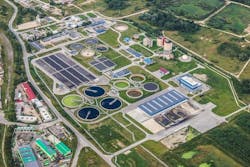Low-Cost Solution to Wastewater Treatment
About two thirds of the world’s population could be living under water-stressed conditions by 2025, according to the United Nations. This pressure on the quantity and quality of an area’s water resources could affect many aspects of life, according to Phys.org. This may lead to higher rates of illness and food and energy shortages.
The EU REMEB (Eco-Friendly Ceramic Membrane Bioreactor based on recycled agricultural and industrial wastes for wastewater reuse) project was launched with the goal of creating a low-cost wastewater treatment system. According to Phys.org, the project developed and validated a novel membrane bioreactor (MBR) that uses ceramic membranes made from recycled materials.
According to Phys.org, the conventional ceramic membranes are costly because of materials like alumina, zirconia and titania oxide used to manufacture them. A popular alternative due to its lower cost is polymeric membrane. While it may be cheaper, the membranes do not work as well in extreme atmospheres and have a short life cycle.
The solution to this problem is recycled ceramic membranes, according to REMEB. They have filtration properties comparable with high-end ceramic counterparts on the market. According to Phys.org, the membranes are made from wastes from the ceramic and marble industries and from olive oil production. The wastes also help to reduce landfill waste volumes, promoting a circular economy.
There are four modules in each MBR. According to Phys.org, each module is 10 m2 in area and comprises 50 membranes. It combines membrane technology with a biological wastewater treatment process. Membranes act as barriers between the biomass and treated water.
The ceramic membranes were made at a ceramic tile company from Spain, according to Phys.org. The technology has been replicated in Italy and Turkey by using waste resources like coffee, hazelnuts, dolomite and shells.
The MBR was tested in a municipal wastewater treatment plant in Aledo, Murcia. The area's treated water is used for agricultural activities, according the project website. Other applications for the technology include garden irrigation and street cleansing. According to Phys.org, the project's technicians will continue their research in order to fully optimize the system and facilitate market uptake.
